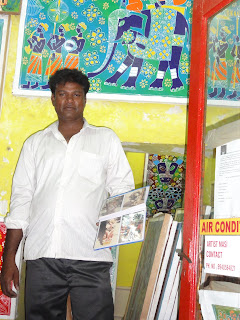While I was doing this project a general term called ‘Divide and Conquer’ came to my mind. Later when I tried to find a specific term applicable to marketing it came out to be Market Segmentation. Market Segmentation is dividing market into a number of segments-consumers with common characteristics who exhibit or are likely to exhibit a particular behavior are kept in one segment. Segmentation can be done in a number of ways - based on demographics, volume, customer profitability etc.
In this particular case below, market has been segmented based on customer profitability i.e. how profitable a customer is and a different price has been set in different segments of the market of the same product.
While roaming around the streets of Mahabalipuram, I came across Masi Art Gallery. The bright colors of the shop suddenly caught my attention. The person who runs the gallery is Masi who has learnt painting and wood carving from his father. Basically he is engaged in three different kinds of paintings - knife work, nib painting and finger work. I particularly liked the finger work where he used his fingers to come up with amazing patterns. The time taken to complete a painting generally varies from two days to several weeks depending on the complexity and theme. It is very difficult to measure the actual margins in this case as it is intellectual capital but what I could make out from his talk was that he was quite happy with the amount he was making. The main expenditure apart from his labour is on brushes, colors and rent of the shop which is Rs 2000.
Now consider a particular product (The painting which is seen in the below picture)
PRODUCT - A nib painting of approx. size 4 feet *3 feet which took him seven days to finish. He was selling only the canvas and not the framed painting as it is difficult to carry framed paintings. Also he did not want the frame to be the guiding factor for choosing a particular painting as some customers as he told had a very specific choice about the frames. He had contact number of shops who can do the framing part and he was happy to give their contact details as he was also getting 10% commission.
He caters to three different segments given below. Each segment given below has a different profitability. Also the price of the painting is not fixed, it varies depending on the segments.
SEGMENT 1-INDIVIDUAL CUSTOMERS
These customers have limited transaction behaviour and are not so profitable customers. His main aim in this segment is to maintain the customer base i.e prevent customer exiting. He has adopted a defensive approach for this category- He has priced the product at ten thousand which he felt was neither very high and nor too low.
SEGMENT 2-HOTELS AND RESORTS
Now consider the second segment-This segment has a high purchasing power and high demand.
So he adopts a more aggressive strategy -He gives a discount of 20% to hotels like New Royal Meridian ,Mamalla Heritage as they buy in bulk and are regular customers and he can ‘t afford to lose such customers. So the painting which he is selling to regular customers at ten thousand is sold to hotels at eight thousand.
SEGMENT 3-PREMIUM CUSTOMERS
This category includes Art galleries in various countries-these are the most profitable customers. Masi takes contact number and details of art galleries in other countries from foreign customers who come to his shop ie from segment 1 customers and then sells it to galleries at almost 3 times the price of what he sells in segment 1, he also receives bulk orders from the art galleries. He also conducts some workshops in Germany and France to maintain long term relationship with customers in this segment.
Therefore I could find out the different strategies Masi used to establish himself in the different market segments. All the segments are important to him to build a brand image for himself and his paintings. Effectively, he is also penetrating into different segments by leveraging the contacts of the customers. As the value associated with paintings is not tangible and is determined by the interaction between Masi and customer, he must maintain a positive image in all customer segments to successfully run the business; he is fairly successful in doing the same.

No comments:
Post a Comment